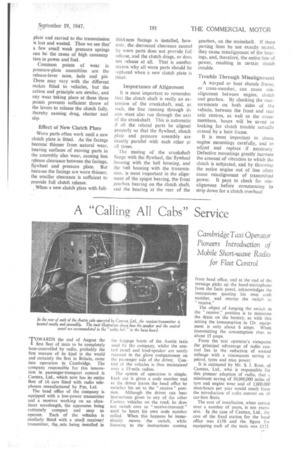A "Calling All Cabs" Service
Page 37

If you've noticed an error in this article please click here to report it so we can fix it.
CarabridkeTaxi Operator Pioneers Introduction of Mobile Short-wave Radio for Fleet Control
T OWARDS the end of August the I first fleet of taxis to be completely base-controlled by radio, probably the first venture of its kind in the world and certainly the first in Britain, came into operation in Cambridge. The company responsible for this innovation in passenger-transport control is Camtax, Ltd., which now has its entire fleet of 16 cars fitted with radio telephones manufactured by Pye, Ltd.
The head office of the company is equipped with a low-power transmitter and a receiver working on an ultrashort wavelength, the apparatus being extremely compact and easy to operate. Each of the vehicles is similarly fitted with a small receiver/ transmitter, the,.sets being installed in the luggage boots of the Austin taxis used by the company, whilst the control panel and loud-speaker are neatly recessed in the glove compartment on the passenger side of the driver. Control of the vehicles is thus maintained over a 15-mile radius.
The system of operation is simple. Each car is given a code number and as the driver leaves the head office he switches his set to the " receive" position. Although the driver can hear instructions given to any of the other Camtax vehicles on the road, he does not switch over to " receive-transmit " until he hears his own code number called. When this happens he immediately moves the switch, while listening to the instructions coming
from head office, and at the end of the message picks up the hand-microphone from the facia panel, acknowledges the instructions quoting his own code number, and returns the switch to "receive," The object of keeping the switch in the receive': position is to minimize the drain on the battery, as with this setting the tonsumption in 12v, equipment is only about 6 amps. When transmitting the consumption rises to about 15 amps.
From the taxi operator's viewpoint the principal advantage of radio control lies in the reduction of wasted mileage with a consequent saving In petrol, tyres and man power.
It is estimated by Mr. S. 1. Rose, of Camtax, Ltd., who is responsible for this pioneer adaption of radio, that a minimum saving of 30,000,000 miles of tyre and engine wear and of 2,000,000 man-hours per year would result from the introduction of tadio control on car-hire fleets.
The cost of installation, when spread over a number of years, is not excessive. In the case of Camtax, Ltd., the cost of the fixed station for the head office was £150 and the figure for equipping each of the taxis was .£125.












































































